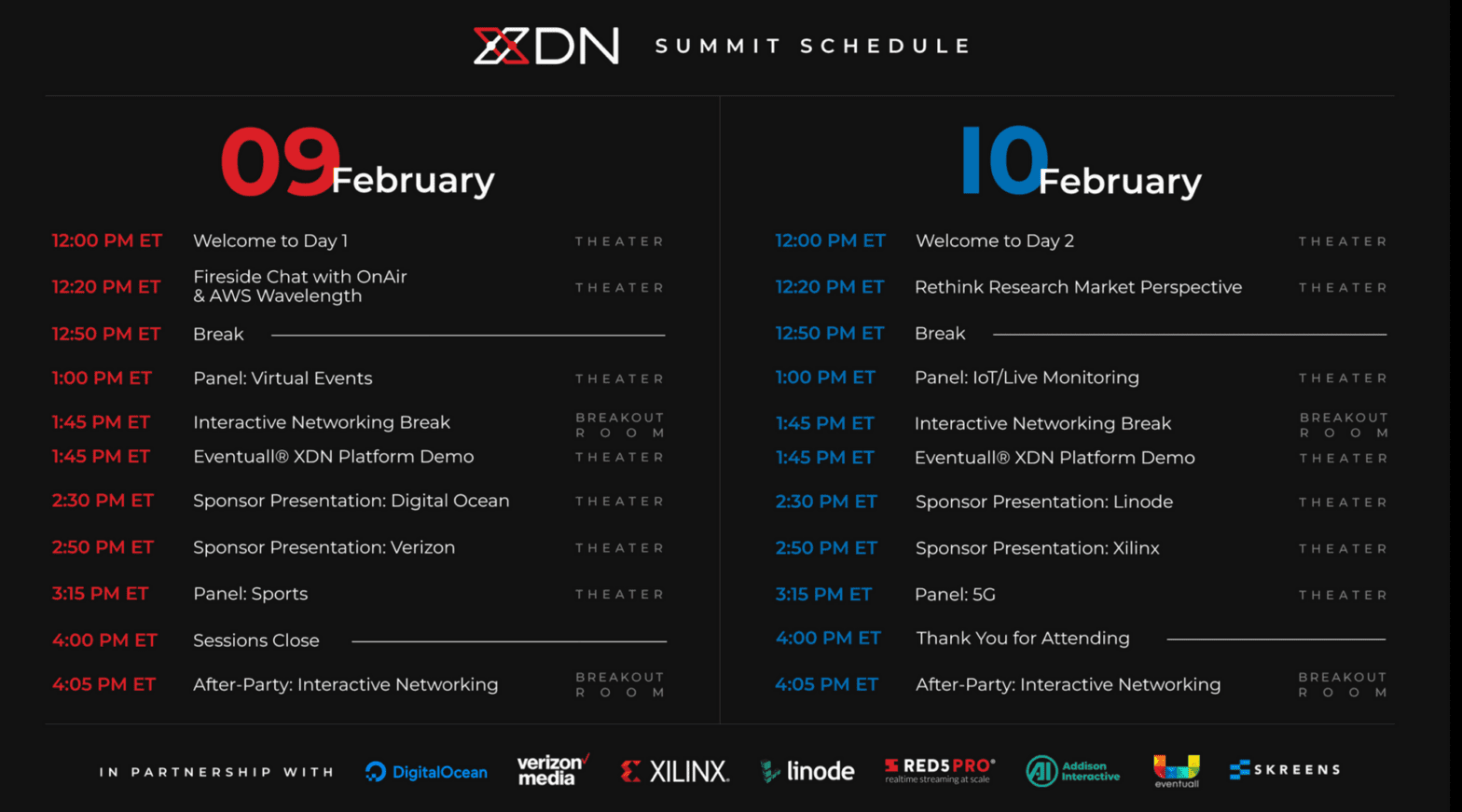Building on the momentum of day 1, the second day of the XDN Summit continued to demonstrate the expansive capabilities of XDN technology. After the team at Red5 Pro and other XDN developers worked overnight to iron out the technical issues from the day before, day 2 offered a smoother streaming experience We further unpacked… Continue reading Day 2: The XDN Effect on Live Streaming Video
Building on the momentum of day 1, the second day of the XDN Summit continued to demonstrate the expansive capabilities of XDN technology.
After the team at Red5 Pro and other XDN developers worked overnight to iron out the technical issues from the day before, day 2 offered a smoother streaming experience We further unpacked how the live streaming landscape is evolving and the immediate need for a reimagined infrastructure that supports the next phase of live experiences. Day 2 featured another round of industry experts demonstrating how XDN streaming delivers the fully scalable, real-time latency, multidirectional video that the future requires.
First up was a marketing perspective from Rethink Research discussing their projections for the live streaming market. Currently, video takes up 69.4% of all internet traffic and is predicted to increase to 75.8%. Interestingly, they forecast that pure WebRTC live streaming will increase to a total revenue of around $3.7 billion by 2025. As WebRTC is the low latency protocol that XDN uses to deliver live video with sub 500ms of latency, this is a very telling statistic.
Next was a panel on IoT/live monitoring with Chris Allen (Red5), David St. Claire (Flir Systems), and Sam Recine (Matrox). They covered how surveillance has never been more reliable with consistent, real-time feedback and dependable performance. Live monitoring for important applications like security, traffic monitoring, and emergency systems for first responders are highly sensitive to real-time information, so ensuring dependable, accurate, and secure live streaming is of the utmost importance. The capabilities of live streaming with IP cameras, drones, and other IoT devices have surpassed industry standards with the latest advancements from XDN including the integration of VR elements.
Jonathan Hill (Linode) then presented their alternative cloud platform. Designed around increasing flexibility to help save on hosting costs, Linode provides a portable hosting solution capable of integrating with other providers such as the major hyperscalers like AWS and Azure.
After Linode, Sean Gardner (Xilinx) covered their work on encoders that decrease the data needed to stream videos while increasing the speed of compression to ensure latency remains low. This is very important to the practicality of streaming applications.
The following session proceeded with speakers Trent Collie (Microsoft), Andrew Heimbold (Singular), Jonathan Hoggard (On Air Systems) and Chris Allen (Red5), who elaborated on the future of 5G. They analyzed how a wide variety of use cases — including live events, remote learning, virtual reality gaming, and immersive entertainment — will benefit from the increased data available under 5G frameworks. The combination of 5G connectivity with XDN tech allows companies to increase production values through the creation of more content, dispersing production, and simplifying the production process. These cutting-edge results will help streamline current capabilities and deploy live streams for an unimaginable user experience.
“With XDN . . . you don’t have to have any kind of download, just pick up the phone, go to a site and — BOOM — you can have all these advanced features.” -– Jonathan Hoggard, On Air Systems
XDN technology offers a next-level approach to networking by offering a DevOps environment that allows partners to work with Red5 Pro, and create a personalized iteration of an XDN that is tailored to meet their specific needs. The XDN summit successfully showcased the importance and need for a widespread implementation of XDN technology, and shared how beneficial it’s been for those who integrate with the Red5 Pro platform.
Screen-sharing with the Eventuall™ Platform
Let’s not forget one of the most exciting parts: Eventuall™, the platform that hosted the XDN Summit was itself built with XDN technology. Hosted on DigitalOcean and streamed by Red5 Pro, of course, the whole summit showcased the current achievements of XDN tech and laid out a promising future for live streaming. Skreens provided the compositing of all the video feeds, while Singular provided digital overlays such as the names and companies of the presenters. Participants could directly experience XDN capabilities simply by joining the summit, not to mention all the information shared in the panel discussions, keynotes, and networking opportunities. A really neat feature where an audience member could be brought in through a video feed to ask a question.
The breakout room.
The breakout room was a very fun aspect where summit participants could move their “person” around to join different conversations arranged around topics like a live video chat messaging board. It was a fantastic networking opportunity that in some ways was easier than awkwardly butting your way into a real-life conversation. Participants were very welcoming as they were anticipating others to join their “circle.”
If you missed it, a video recording will be available soon.
For more information on how to take advantage of the XDN platform, Red5 Pro has produced an informative white paper titled The World Needs an Interactive Streaming Infrastructure that outlines the fundamentals of live-steaming and shares which companies are currently implementing XDNs for commercial use. You can also contact us directly by emailing info@red5pro.con or scheduling a call with us.
